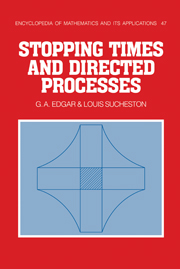9 - Multiparameter processes
Published online by Cambridge University Press: 21 January 2010
Summary
We present here a unified approach to most of the multiparameter martingale and ergodic theory. In one parameter, the existence of common formulations and proofs is a well known old problem; see e.g. J. L. Doob [1953], p. 342. It has been known that the passage from weak to strong maximal inequalities can be done by a general argument applicable to harmonic analysis, ergodic theory, and martingale theory. In this book a very general such approach is presented in Chapter 3, involving Orlicz spaces and their hearts. There exists also a simple unified (martingales + ergodic theorems) passage from one to many parameters using no multiparameter maximal theorems, based on a general argument valid for order-continuous Banach lattices. This approach gives a unified short proof of many known theorems, namely multiparameter versions of theorems of Doob (Cairoli's theorem [1970] in stronger form, not assuming independence), theorems of Dunford & Schwartz [1956] and Fava [1972], the multiparameter pointtransformation case having been earlier proved by Zygmund [1951] and Dunford [1951]. We also obtain multiparameter versions of theorems of Akcoglu [1975], Stein [1961], Rota [1962]. For the Banach lattice argument, the order continuity is needed, which means that the L logkL spaces are not acceptable if the measure is infinite: they fail this property and have to be replaced by their hearts, subspaces HΦ which axe closures of simple integrable functions (see Chapter 2). We will first develop in detail the “multiparameter principle” (Theorem (9,1.3)) that allows the reduction of multiparameter convergence problems to one parameter. There is also a one-sided version of this result, useful to prove “demiconvergence” in many parameters.
Information
- Type
- Chapter
- Information
- Stopping Times and Directed Processes , pp. 382 - 406Publisher: Cambridge University PressPrint publication year: 1992
